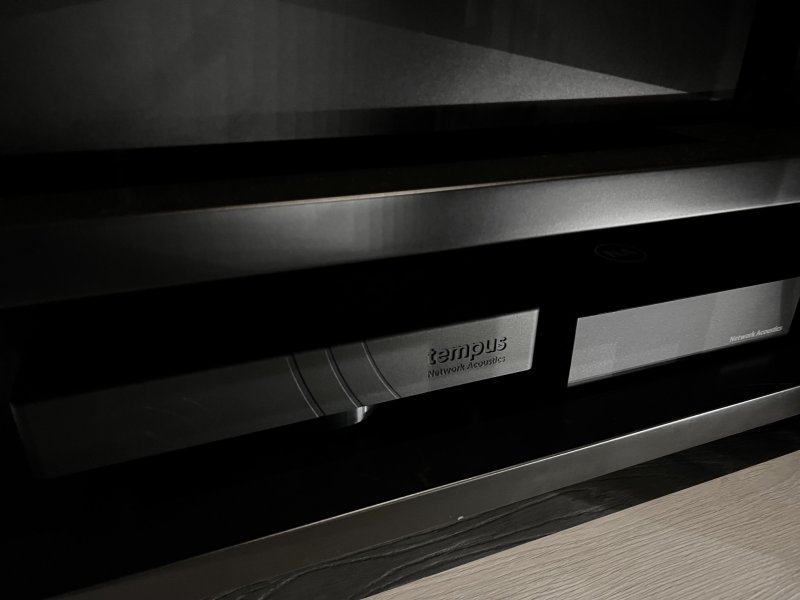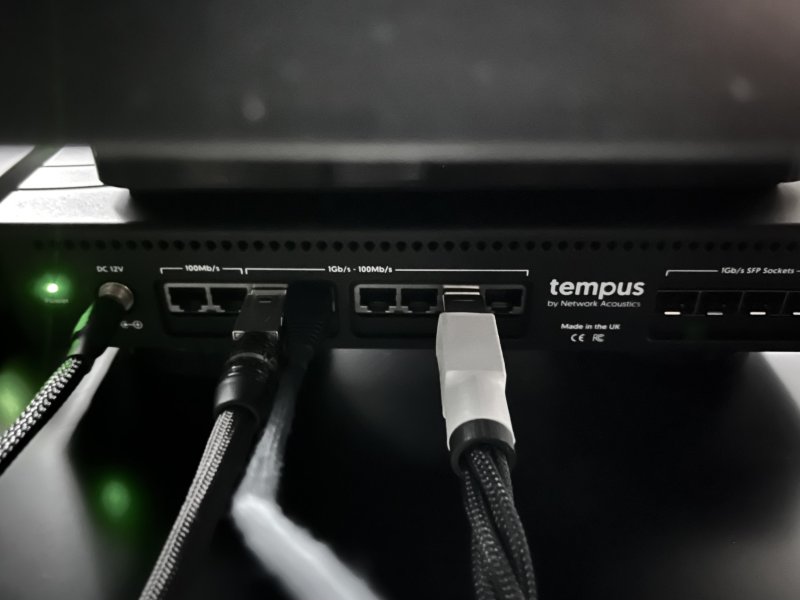
I always was reluctant to consider a different switch in my system. I thought that pairing two units of the same brand was the correct way to implement an audio network, Innuos Statement server/streamer and Innuos PhoenixNET switch in my case. Easy peazy!
When I tried the Muon Pro filter from Network Acoustics for the first time I realized that in digital domain we have to keep an open mind. There are no rules and absolutes, we have to learn yet.
This is the reason why I was excited to try the Tempus switch, maybe it would have broken my one-brand-only-rule (or confirm it, since I already have the Muon Pro in my chain).
Once introduced the Tempus in my system I immediately noticed a profounder and blacker background (I know, I know… an obvious sentence in these cases… just like I didn’t know such a black silence because I never heard it before bla bla). But it was there and easy to hear, period. It implied also a lot more details and micro dynamics, and a big smile on my face.
It clearly appeared the perfect synergy between Muon Pro and Tempus, as expected the same “sound signature” was evident, or better that kind of effectiveness in reducing noise, with all the desired benefits as logical consequence.
One of the best qualities of the PhoenixNET is the naturalness and the realism that is capable of, that I really love. It was immediately clear that the Tempus was able to bring the same effect (no coloration or “digital feeling” at all).
First box, checked!
What I didn't like was the bass, according to my first impressions, too slow and compressed.
But the mids were so realistic, open and airy that I decided to postpone any conclusions and simply enjoy the music I was hearing with such immersive tones.
Second box, mmm on standby.
And the voice, oh that voice right in front of me, so real, so palpable and vibrant, every breath defined the singer's facial expression, every word so rich and natural. How beautiful!
Third box, checked.
A wider soundstage doesn't necessarily mean better quality, but in this case I liked the result of a slightly more extended sound to the sides. Just enough to appear as realistic as possible. And a nice separation of instruments on the stage. All well proportioned, so to speak! Little details emerged here and there, never heard before in my uber familiar tracks that I use for reference. Light touches of cymbals, echoes of plucked strings, soft reverberations from the space of the venue. Small things, great pleasure.
Compared to the Tempus, my previous PhoenixNET began to appear darker, dryer and more veiled to my ears and above all with a somewhat recessed image. Indeed once I got used to the Tempus, it was clearer to me what the new switch was capable of: the music started to flow easily, with a well-balanced and organic, fresh and relaxed sense of pace and rhythm. Truly a pleasure to listen to, engaging and harmonious in its simplicity. I had a feeling of contentment and tranquility!
After the first 36 hours of listening, the doubts initially found about the bass were finally resolved. As if they had slowly melted with the running-in, becoming tighter and faster, better linked to the other frequencies and above all much much more enveloping and rounded. They lost that sort of dryness and became rich and textured. The sense of liquidity and harmony gradually grew, increasing the sensation of pleasantness, harmony and ease of listening.
The sound never appeared excessively bright, anything but forced or fatiguing despite clarity and transparency often tend to bring out increasingly richer details, minute and imperceptible details or nuances that risk to have contraindications like sterilized artificial effects. This is not the case, the general feeling has never been compromised by the typical "hifi" sound, on the contrary the naturalness of the musical representation has always been decidedly appreciable. I would say that the best quality of the Tempus is precisely in the noise reduction, such a silent background I believe is the real reason why all the other pleasant attributes found when listening were able to emerge. I would say that knowing the Muon Pro filter, the improvement brought by the Tempus goes exactly in the same direction.

Physically both the units are rock solid and really well built, I’d suggest to NA considering the PSU/switch of the same form factor in order to let them stacked with the power supply under the Tempus. Why? Because of the heavy weight of many audiophile power cords normally plugged into the IEC inlet, that may cause instability issues when placed upon the switch chassis, being the PSU lighter than some enormous cables.
Having enough room on my rack I preferred placing the units separated side by side on the same shelf, in that way it was certainly easier to handle the cables behind but I also got the impression to gain an even better black background. Curiously I had the feeling of an higher level of volume as a consequence.
NA intentionally ommitted the inclusion of earthing post in Tempus’ design. In their opinion one of the reasons Tempus sounds as good as it does, is due to its completely unique power supply and power implementation design. They told me “The way the filtratiion is designed means there is no benefit to earthing either the power supply or the switch”.
I could easily live with my PhoenixNET for years to come, it just sounded so natural and realistic, I loved it! But after listening to the Tempus, oh, now I understand how it is possible to elevate my pleasure even more. My comparison in this review is not meant to find a winner, after all music and our enjoyment should be the real winners in this hobby. It’s a matter of personal taste and I’m pretty sure my ears prefer the sound of the Tempus switch, for a variety of reasons, the most significant of which is thatI I like what I hear better, what else?

All the evaluations carried out refer to the same pre-existing set up, therefore with the Muon Pro between the router and the switch. This is to have a direct comparison with the system configuration using the PhoenixNET.
I also experimented with the Tempus by placing the Muon Pro, as NA usually recommends, between the switch and the streamer. This involved changing the Ethernet cables I was actually using (Pink Faun Interlink on the router side and STEALTH on the streamer) due to their different lengths.
Here are my thoughts:
Muon Streaming > STEALTH Ultra + Pro (
SCORE 7,5)
Plus = openness | voice
Minus = liquidity | soundstage width | separation
STEALTH Ultra > Muon Streaming + Pro (
SCORE 8)
Plus = voice | detail | airy
Minus = liquidity | realism
STEALTH Ultra > Pink Faun Interlink + Pro (
SCORE 9!!!)
Plus = realism | naturalness | lifelike | engaging | textured | micro dynamics
Minus = NN
Long story short: it seems like cables matter just as much as placement upstream or downstream of the Muon Pro filter mostly the last cable from the Tempus to the streamer/filter, to be honest. My choice is confirmed regarding the cables used and the best perception obtained in terms of naturalness and pleasantness of the sound.
The Tempus’ PSU really shines in reducing noise, keeping dynamics and openness pretty enjoyable so I hope NA will be able to launch a PSU specifically designed for powering routers, assuming this hybrid technology will bring positive effects also to this last devices upstream the network.
We often read about improvements obtained by putting two switches daisy chained, I could try placing the PhoenixNET between the router and the Tempus. I'm just worried that it might form a bottleneck, since it's designed to operate at 100 Mbps while the Tempus and the Muon Pro are specifically designed to work best at 1 Gbps.
Conclusions
The current improvement has truly taken my system to a new level in terms of perceived sound quality. The main factors can be traced back to:
- the introduction of Tempus and its ability to work in splendid synergy with the Muon Pro
- the positioning of the Muon Pro, now downstream
- the choice of Ethernet cables in play and their positioning, in particular exchanging the STEALTH (now upstream) with the Pink Faun (now downstream)
Due to the results obtained, the Tempus will remain in my system.
Here below my usual chart comparing the Innuos PhoenixNET with the Tempus:
| | |
| | PNET | TEMPUS |
| White noise/Hum. | 9 | 9 |
| Background | 8 | 9 |
| Naturalness | 9 | 9 |
| Image precision | 8 | 8 |
| Soundstage depth | 8 | 8 |
| Soundstage width | 8 | 9 |
| Separation | 8 | 9 |
| Voice | 9 | 9 |
| Hights | 7 | 8 |
| Bass | 8 | 8 |
| Presence | 9 | 9 |
| Transient | 8 | 9 |
| Clarity | 8 | 9 |
| Airy | 7 | 9 |
| Detail | 8 | 9 |
| Unveil | 8 | 9 |
| Realism | 9 | 9 |
| Calm | 8 | 8 |
| Control | 8 | 9 |
| Engagement | 8 | 9 |
| 8,2 | 8,8 |













